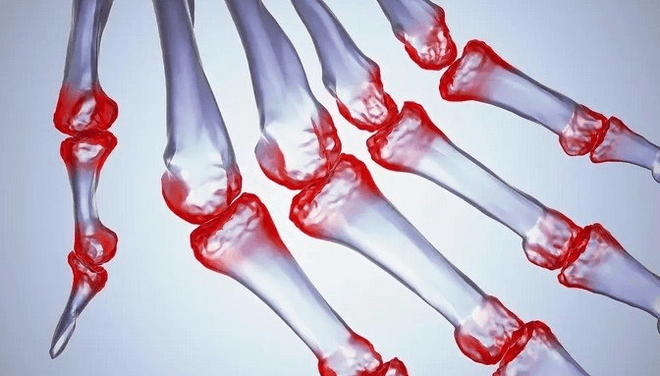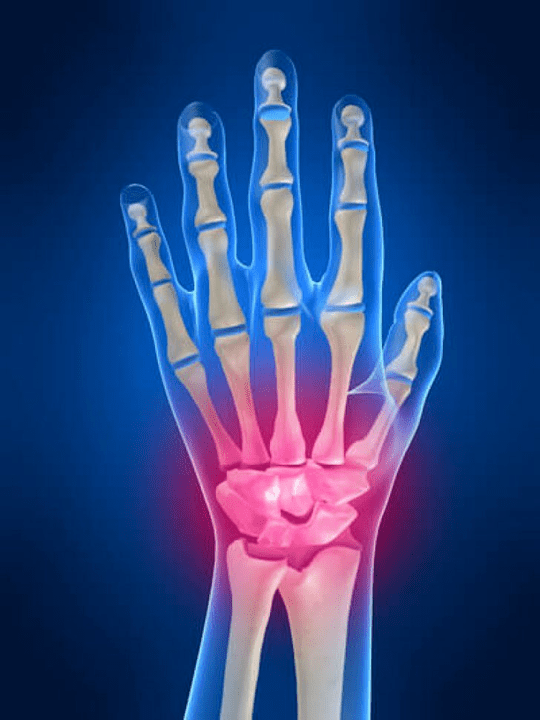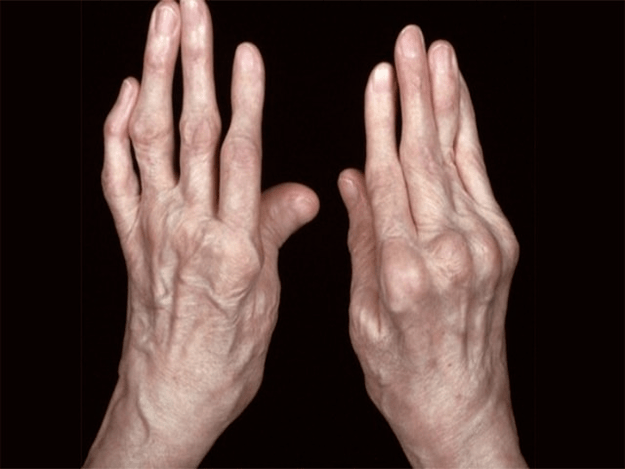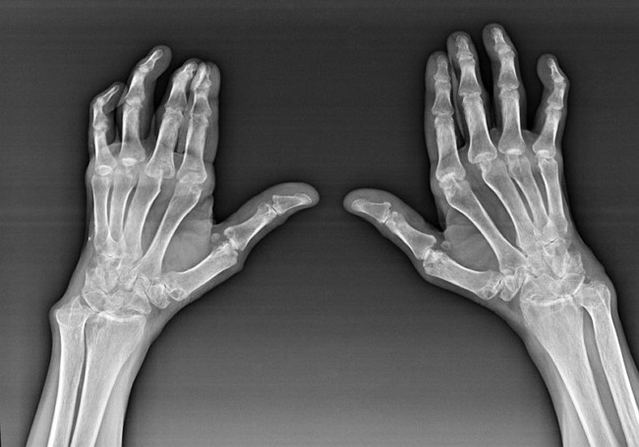
Joint painThe fingers are an indispensable sign of a common pathology in which the structural components of these compounds are damaged.First, pain in the area of these joints can be associated with various autoimmune diseases (Systemic red shine, rheumatoid arthritis, psoriasis arthritis, etc.) in which immune factors damage their own joint fabric.
The next main reason that can initiatepainThere can be injuries in the fucking of the fingers (Bruises, transfers, broken bones, ligaments).Pain in these joints can also be provoked by degenerative changes in their joint fabrics.This can often be observed in osteoarthritis.
Anatomy of hand connections
All hand connections are common to be divided into the following groups:
- Wrist joint;
- Joints of the wrist;
- Cartel connections;
- Interpencial joints;
- Parlemonal-phalanx joints;
- Interphalanx joints.
The wrist joint
The wrist joint is formed by the bones of the proximal bones (upper) a number of wrists (Trihedral, crescent moon, scaphoid bones) and distal areas of radiation and elbow bones.The elbow bone is not directly connected to the bones of the wrist, but with the help of distal (Lower) The joint disc.This structure separates the cavity of the wrist joint from the distal cavity (Lower) The tile joint.
Joints of the wrist
The joints of the wrist are shown by three types of joints.The first form includes the compounds that are between the bones of the upper bone (upper bonesScaphoid, Semi -Moon, Trihedrisch, Erbsen -) or the lower row (Hook -shaped, headed, trapezoidal, bone case).These joints are referred to as replacement joints.After the second type, the Mid -Wrist joint, mentioned in this way, is classified.This connection has an S-shaped shape and is formed due to the connection of the bones of the upper and lower row of the wrist.The third type includes the connection of the pea bone.This joint is connected to the peasic bone.
Capacen-Penal joints
The Karpal Panel joints connect the bones of the wrists and the meta-carpal bones.These connections are formed by the contact of the proximal ends (Terrain) The metacarpal bones and distal sections of carpal bones to the second row.The carpal pattern compounds include two main joints.The first is the carpall piece of the thumb.It is formed by connecting the first meta -carpal bone with bone falcons.
The second joint is the common carpal path connection for the rest of the Karpal Prypyna compounds between the second, third, fourth, fifth metacarpal bones and trapezoidal bones and partly a section of the bone.The farm pattern connection of the thumb is separated from the entire carpal pattern connection.Due to their more active movements compared to the remains of the carpal path (which are generally included in the general carpal pathway joint) which are considered sedentary.The Karpal Panel joints are strengthened by strong joint capsules and ribbons (ligaments (Baking and palmar handbaging ligaments).
Interpretation joints
The lateral surfaces of the second, third, fourth and fifth meta -carpal bones form when they are contacted from each other, interprex joints.These joints have separate joint capsules that are closely connected to the joint capsules of the carpal paths.In addition to the capsules, these joints have a band apparatus, which are shown by inter -sixty metacarpal tapes and the rear and palmar pair straps.The interpener compounds are attributed to the sedentary hand joints of the hand because the articular surfaces of the bones that form these joints have a flat shape.
Parleen-Phalanx joints
Parleus-Phalanx joints are connections between distal (lower) with the ends of the metacarpal bones and proximal (proximal (upper) Areas of the first phalanges of the fingers of the hand.Each finger of the upper limb has its own metacarponal joint.So there are five metacarpal phalanz joints on each hand.
Interphalanx joints
Interpophalanx joints are formed by the combination of neighboring phalanges each of the fingers.Large (First) The finger only has an interpreted joint because this finger only has two phalanxes (proximal and distal).The rest of the finger of each hands has two interfaly joints.
The first of them is between the first (proximal) and the second (Average) Fingers and called proximal phalanges (upper) Interphalang joint.The second forms the connection between the average (second) and the last (distal) Fingerphalanges.The second interphalangeal joints are referred to as distally interfalized joints.The Inter -Phalanx joints are strengthened with collateral and palm bands.These joints belong to the block connections, the movements of which are only possible around the frontal level (Fights and bending).

What structures can ignite in the joints of the hands?
Inflammation is a typical pathological process that is characteristic of these tissues and organs that have been damaged for some reason.It should be remembered that in most cases every disease (For example gout, rheumatoid arthritis, etc.) or trauma that damage the hands connections to one or the other degree not only affects the joint, but also the periert (Nerves, muscles, tendons, subcutaneous fat, skin) Structures.
The following joint structures can ignite in the joints of the hands:
- common cartilage;
- Squeeze bone tissue;
- Joint capsule;
- Common ligaments.
The causes of pain in the hand and fingers joints
The main part under the reasons that cause pain in the hand and fingers to pain is occupied by mechanical injuries (Fractures, transfers, bruises, etc.) and systemic autoimmune diseases (Rheumatoid arthritis, systemic lupus erythematodes, psoriasis etc.).In addition to these causes, pain in the hand associations can cause diseases associated with metabolic disorders (For example gout, osteoarthrosis).

There are the following main causes that cause pain in the joints of the hand and finger:
- Bruise on the hand and finger;
- Break of brush bones;
- Transfer of the brush;
- Lesion of ligaments of the hand;
- Rheumatoid arthritis;
- Kinbek disease;
- Reactive arthritis;
- Gout;
- Psoriasis arthritis;
- Synovitis;
- Osteoarthrosis;
- System Red Lupus.
Brush and finger blue
Bruise is one of the types of closed injuries in which soft tissue is damaged (Muscles, tendons, nerves, skin) And there are no wounds where the main effect of the traumatic factor was directed.Bruises of soft tissue by hand and fingers are very rarely isolated (isolated (isolatedseparately) from bruises of the hand and finger joints.Therefore, mixed symptoms are found in this type of injuries, which is both damage to the hand fuks and on the lesion of the periartic (Peri people) Fabrics.The blue spots of brushes and fingers are usually found on the hand when falling, they damage them with a blunt object with its compression or plugs.
Very often bruises of the cystic zone lead to the main trunks of the medians, radials, elbow nerves (the main tribes of the medians, radials, elbow nerves (what the area of the hand and finger inner), which immediately manifests the disappearance of the motor functions of the fingers through the loss of skin sensitivity and in some cases.
The inflammatory edema of the joint and permeable structures develops through the expansion of numerous vessels that they are blood supply.This edema is one of the reactions of the inflammation that occurs in response to damage to tissues during the bruises.
A fracture of the brush bones
Very often the cause of pain in the handrails can be different fractures of your bones, since these bones register directly in the formation of articular areas.Depending on the anatomical position of the damaged bone, all fractures are divided into three main groups.The first group includes fractures of the wrist bones.The second includes fractures of tubular metacarpal bones.The third group includes fractures of bones of the phalanges of the fingers.
The most common damage in the brush's carpal zone are crescent moon and scaphoid bones.A fracture of this bone occurs during the falls on the brush and is accompanied by pain in the area of the wrist and with medium wrists.Pain syndrome can also be observed in places in the anatomical localization of these bones.
The most common fracture of the ends of the meta -carpal bones is a fracture of the base of the first meta -carpal bone (The one who is attached to the phalanges of the thumb bones).With this injury, edema and pain occur in the zone of the base of the first midfoot leg bone as well as in the part of the carpal pattern joint, which are directly side by side.The thumb with such a fracture is shortened, bent and led to the palm.His movements are limited.
Fractures of the Phalanx of the brush are accompanied by deformation, a decrease in the length of the finger, the loss of their function, sharp pain and swelling in their Inter -Phalanx joints and permeable tissues.With fractures of phalanges the finger with a shift of bone fragments, palpation (palpation (With palpation) You can identify your exploitation on the palm surface of the brush and on the contrary on the back a hole or insulation.These fragments are usually mobile, nearby you can often recognize subcutaneous bleeding (Hematomas).
Shifting the brush
The transfer is a pathological state in which the areas of bones that form a joint go beyond their anatomical borders, which are thus manifested by a complete or partial loss of the function of this joint.In addition to impairing the joint function in transfers, severe pain in the affected joint, swelling and a local temperature increase are also determined.During the transfer of the brush, the occurrence of a swelling is explained not only by the presence of inflammation in damaged perimen tissue as well as by the structures of the joint, but also with a lead of the broadcast bone joint.
The most common types of transfers of the brush
| The name of the transfer | The mechanism of transfer | Which joint is amazed? |
| True transfer of the brush | The joint surfaces of the wrist bones are displaced relative to the joint surface of the radial bone towards the palm or back of the hand. |
|
| Perilunar Dislocation | The bones of the wrist and the rest of the brush are moved relative to lunch and radial bones in the back of the brush. |
|
| Bone loss | At the same time, the scaphoid bone shows the transfer in the radiation side in parallel (In the same aircraft) to the nearby bones of the wrist.Sometimes it can move on the Palmar side, i.e. to switch to the palm trapping palm trapping, less often on the same side of the trapezoidal bone. |
|
| Lights of the Semi -Moon | In the direction of the palm is a slide of the crescent moon, so that the room does not remain busy instead of this bone.It is gradually occupied by the headbone and penetrates from the second row of the bones of the wrist.This transfer is a complication of self -regulation of the perilunusuation. |
|
| Transfer of the first meta -carpal bone | The joint surface of the base of the first meta-carpal bone is relative to the joint surface of the bone trapping in the radiation side (moved upwards () () ()proximal) and in the same level with the bones of the wrist.So the thumb is pulled back a little and pulled towards the wrist joint. |
|
| Lights of the phalanges of the fingers | There are transfers of the fingers in the metacarpophalangeal joints and the interphalanx joints.On the first the joint surface of the proximal phalanx of the fingers (fingers (Together with the whole finger) Shift relative to the joint surface of the meta -carpal bones.In the second there is a shift between the bones of the phalanges of the finger itself. Usually there are back and palm injuries of the phalanges of the fingers. |
|
Damage to the hand bands
The lesion of the tapes together with blue spots on the brush is attributed to closed traumatic damage.This pathology is mainly found in any direction with excessive expansion of the hand and fingers.The main types of lesions of the brush heap are their stretching and breaking.When stretching in the damage zone, light RE voltage and partial fracture of the connective tissue fibers are observed.With the break of the league, the entire volume is divided into two endless ends.
The following main types of the tapes of the brush are differentiated:
- Break of the radial collateral band of the wrist;
- Break of the elbow collateral band of the wrist;
- Break of intercept straps;
- Break of the side tapes of the metacarpal phalanz joints;
- Break of the side ligaments of the interphalang joints.
Rheumatoid arthritis
Rheumatoid arthritis is a disease in which the human immune system damages the body's own tissue.In other words, rheumatoid arthritis is an autoimmunpathology.This disease is also systemic because many fabrics are affected (((Muscles, joints, vessels, etc.) and organs (Heart, kidneys, lungs, etc.) in the body.
Despite the fact that rheumatoid arthritis is a systemic disease, the joints suffer to a greater extent, while the lesion of other tissues and organs is in the background.With this disease, almost all types of brush joints can be affected (Brace walls, carpal paths, Metacarpal-Phalanx, Interpalanx joints).The lesion is usually symmetrical (this.The same connections are affected) Pain in damaged joints, accompanied by swelling.In the morning, while lifting out of bed, there is a certain stiffness in the affected joints, which last about 1 hour and can then disappear without trace.
Very often with rheumatic arthritis near the affected joints of the brush (More often the piano-phalanx interphalanx joints) Rheumatoids appear.They are a rounded formation that is under the skin.These formations are most common on the back on the brush.With palpation they are tight, inactive and painless.The number of them can vary.
Kinbek disease
The Kinbek disease is a pathology in which a semi -moon carpal bone is affected by the brush.The disease develops due to a long -term physical overloading of the palms.Usually it occurs in specialists for construction professions - plasters, bricklayers, carpenters, etc. Excessive physical activity of the palms of the palms of the palms of the palms of the palms most frequently in this bone, since it takes the central position in the wrist.Most of the time during the illness of the Kinbek, the brush is affected and usually the main thing (The right hand is damaged, the left hand is damaged).
Reactive arthritis
Reactive arthritis is a pathology of immunopathological genesis, in which its own immune system attacks various joints in the body, which is why autoimmune inflammation develops.In contrast to other autoimmune diseases (For example rheumatoid arthritis, systemic lupus erythematosus, in which an infectious origin is adopted) In reactive arthritis, a clear connection between the infection is pursued (((And in particular intestines or urogenital) and the development of common lesions.
With this pathology, lymph nodes can also increase and fever appear.If reactive arthritis merges into a chronic form, patients can occur over time. Bursitis can occur (occurrence (occurrenceInflammation of the periosemantal pockets), Tendovaginites (Inflammation of the tendons vagina) and other.
gout
Gout is an illness based on the development of the accumulation of uric acid in the body and its deposition in the form of salts in the joints.Uralgsic acid is the end product of the metabolism of purine and pyrimidine bases.They serve as the basis for the establishment of DNA and RNA molecules, some energy formations (Adenosine trifosphate, adenosine monophosphate etc.) and vitamins.
Pain with gout mainly occurs in the small joints of the lower and upper extremities.In addition, the disease begins in 50% of all clinical cases with the first plus joint of the legs.As a rule, the interpreted joints of the fingers are usually less often affected, less often - radiant joints.Gout usually damages one or more joints on a limb, sometimes the joints of other limbs are involved in the inflammatory process.
Psoriasis arthritis
Psoriasis arthritis is a pathology in which various joints are inflamed against the background of psoriasis.The development of psoriasis is based on a violation of the interaction between immune cells and skin cells as a result in the body (and especially in the skin) There are autoimmune reactions that cause inflammation.
Synovitis
Synovitis is an inflammation of the synovial shell of the joints, which is accompanied by damage to their tissues and the accumulation of pathological liquids in the affected joints.Synovitis is not a separate illness, but serves as a complication of other diseases.It can occur with endocrine, allergic, contagious, autoimmune pathologies, brushes, etc.
Osteoarthrosis
Osteoarthritis is an illness in which the educational processes of normal cartilage tissue violate different joints.These processes are violated under the influence of certain external and internal predisposing factors.You can be constant joint injuries, longer physical activity (At work, in everyday life, during sports), Inheritance, other common diseases, etc.
The joints of the fingers are sore with this pathology because in the periartic (Peri people) The tissues occur, the nerves are affected.A characteristic feature of osteoarthritis is the connection of pain with physical activity.Pain in the joints appears mainly with and/or after severe physical overload and disappears in peace or after calm.
System Red Lupus
A systemic lupus erythematosus is an autoimmunpathology in which an immune system of autoimmunantibodies is produced in the human body and attacks various structures of cells and tissues.In particular, the production of the so -called anti -Kore antibodies is observed, which damage cell nuclei and DNA and RNA molecules.Various fabrics and organs are affected with a red lupus - leather, vessels, heart, pleura, pericardium, kidneys, joints, etc.
System Red Lupus is constantly associated with other additional intact signs - weakness, weight loss, fever (Improve body temperature).However, special symptoms are of the utmost importance, without which the diagnosis of red lupus is not made.These special signs are photodermatitis (Dermatitis under the influence of sunlight), discoid rash (The appearance on the skin of the neck, the chest of red papers), Lupoid Butterfly (The appearance of red spots on the skin near the nose), Erosion in the oral cavity, kidney damage (Glomerulonephritis), Serosites (Inflammation of serous membranes) and other.
Diagnosis of the causes of pain pain

The hands of pain in the hand joints are busy with the diagnosis and treatment of the causes of pain, mainly a traumatologist and A-cerry doctor.To diagnose such reasons, these doctors mainly use clinically (Anamnesis collection, external inspection, palpation, etc.), radial (Radiography, computer tomography) and laboratory (General blood tests, biochemical blood tests, etc.) Research methods.
Depending on the cause of the pain in the handrails, all diagnostics can be divided into the following sections:
- Diagnosis of traumatic brush injuries (Bruises, transfers, fractures, ligaments);
- Diagnosis of rheumatoid arthritis;
- Diagnosis of Kinbek disease;
- Diagnosis of reactive arthritis;
- Gout diagnostics;
- Diagnosis of psoriasis arthritis;
- Diagnosis of synovitis;
- Diagnosis of osteoarthritis;
- Diagnosis of the systemic lupus erythematacy.
Diagnosis of traumatic brush injuries
If the brush is injured, you should consult a traumatologist.The main diagnostic methods used in medical practice to identify traumatic damage to the brush (Fractures, transfers, ligaments, bruises), are an external examination, anamnesis, radiation methods of research (Radiography, computer tomography).
The collection of anamnestic data enables the doctor to identify incidents that could lead or lead to a violation of the brush.The history of the anamnesis is also used to clarify the symptoms that disturb the patient.During an external examination on the brush, it is possible to determine swelling, hematomas, their deformation, restricting joint mobility.With the help of palpation, the doctor shows the presence of pain, violation of the anatomical form of the connection, damage to the ligaments.Radiation methods of research (Radiography, computer tomography) They enable them to confirm the diagnosis, since mechanical damage to the anatomical formations of the brush are clearly visible during their use.
Treatment of pathologies that cause inflammation of the wrists

For the treatment of causes of pain in the hand and fingers of pain, doctors first prescribe a variety of medication (Anti -inflammatory, painkillers, anti -rhevetas drugs etc.).In some cases, they combine the use of these products using physiotherapeutic methods.The traumatic damage to the brush is most frequently treated surgically or applied to the affected upper extremity of the plaster band.
In order to relieve pain and relieve inflammation, first aid can be the use of an external NSAID.The drug selectively blocks the COO 2 and acts directly on the pain source.Thanks to a special texture, it is quickly absorbed, leaves no traces of clothing, has a pleasant smell.
Depending on the pathology that causes inflammation in the hand associations, the entire treatment can be divided into the following parts:
- Treatment of traumatic injuries to the brush (Bruises, transfers, fractures, ligaments);
- Treatment of rheumatoid arthritis;
- Treatment of Kinbek disease;
- Treatment of reactive arthritis;
- Gout treatment;
- Treatment of psoriasis arthritis;
- Synovitis treatment;
- Treatment of osteoarthritis;
- Treatment of the systemic lupus erythematacy.
























